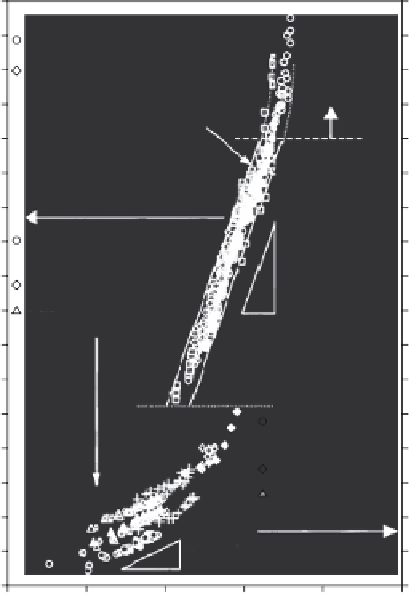Environmental Engineering Reference
In-Depth Information
gain basic understanding about the material behavior. It has been recog-
nized that hoop strain in a clad tube is a vital parameter in the breach of fuel
clad, and evaluation of their creep and burst behaviors is very important to
assess the integrity of the tube.
117
Steady-state creep-rates at relatively high
(>5 × 10
−4
E
) followed the same behavior as described earlier exhibiting
power-law creep behavior with exponential dependence at higher stresses
and were identifi ed as due to dislocation glide-climb creep mechanisms. At
low stresses, viscous creep with the characteristic
n
= 1 was indeed reported
as expected. Figure 3.29 summarizes the various sets of results in terms of
Dorn parameters for Zr-alloys.
118
Bernstein
119
observed that both Zircaloy-2
and pure Zr exhibit a stress exponent value of unity at low stresses which
increases to 4.6 and 6, respectively, at higher stresses. The data produced by
MacEwen
et al
.
120
also showed that the
n
increases with stress (for compa-
rable
-Zr with
comparable purity and in the comparable low stress range, but at slightly
higher temperature, showed a stress exponent value of 7.5 and the
n
value
reduced at higher stresses indicating operation of series mechanisms (see
σ
/
E
). On the contrary, data from Ardell and Sherby
121
for
α
Zirconium
10
-1
10
-7
Pahutova
et al.,
99.8%, 400-750°C
Bernstein 99.95%, 567°C
Power-law
breakdown
10
-3
10
-9
Ardell
et al.,
99.8%, 660-810°C
Gilbert
et al.,
99.8%,50-850°C
Warda
et al.,
99.95%, 450-550°C
10
-5
10
-11
MacEwen
et al.,
99.95%, 597-702°C
10
-7
10
-13
Novotny
et al.,
99.8%, 470-750°C
Prasad
et al.,
99.8%, 540-604°C
Bernstein 99.95%, 520-620°C
Fala
et al.,
99.8%, 475-700°C
n
~ 6.4
10
-9
10
-15
10
-11
10
-17
1.58-243
μ
m
10
-13
10
-19
1.6-55
μ
m
4.5-62
m
4.8-87
μ
m
μ
10
-15
10
-21
n
~ 1.1
10
-17
10
-23
10
-6
10
-5
10
-4
10
-3
10
-2
10
-1
σ
/
G



Search WWH ::

Custom Search